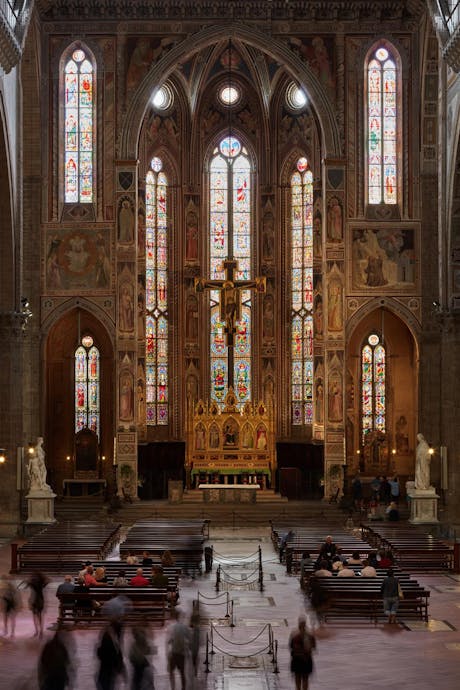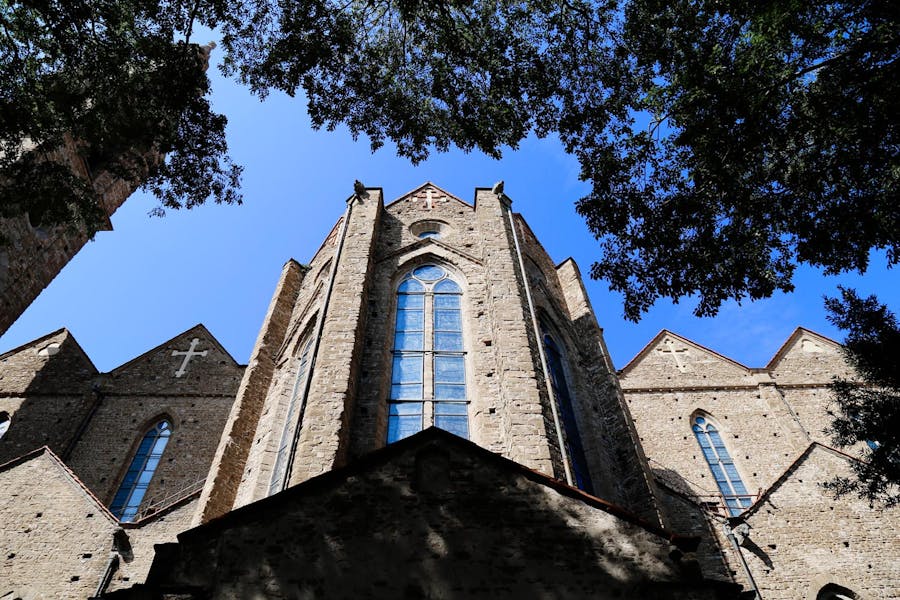
Basilica
Santa Croce is the most monumental of all Franciscan churches. According to historian Giovanni Villani, the foundation stone was laid on 3 May 1294 in the course of a solemn ceremony attended by the city authorities. A plaque in the south aisle, however, shifts the event to 1295 and scholars today tend to consider the latter to be the more reliable date.
The design was entrusted in all likelihood to Arnolfo di Cambio, the greatest architect of his day, who also built the cathedral of Santa Maria del Fiore, Palazzo Vecchio and other buildings in Florence.
The church is a Latin cross in plan. Five east-facing chapels open off the transepts on each side of the chancel chapel, in addition to which the arms of the transept also contain chapels. The nave and side aisles are separated from each other by octagonal piers surmounted by pointed arches.
Thus the nave – 34 mt. long and 20 mt. wide – merges with the side aisles to convey the feeling of a single, huge space reminiscent of the early Christian basilicas in Rome, but the lively rhythm of the surfaces underscored by the textural contrast of pietra serena stone, plaster and terracotta echoes the new style reaching Italy from France. As in other Italian buildings, however, so here too the Gothic verticality of northern Europe is attenuated by a ceiling of wooden trusses rather than vaulting and by walkways running above the nave arcades.
The interior is lit by stained-glass windows that were an integral part of the original design. Santa Croce is one of the few Italian monuments with its original stained-glass windows ranging from the 14th to the 19th centuries still in place.
The chancel area was virtually complete before Arnolfo died some time between 1302 and 1310. The transepts were ceiled with painted beams in 1314 and the south transept was already in use by 1318. Demolition went ahead shortly afterwards on the old church , remains of which have been unearthed beneath the present nave.
Once the transepts had been completed and several of their chapels frescoed, work continued on the aisles, possibly on the far side of a temporary wall. The church was solemnly consecrated by Pope Eugene IV only in 1443, even though it had been complete for about half a century by then.
A masonry rood scene separating the clergy from the congregation stood between the fourth and fifth piers until Giorgio Vasari demolished it and the chapels built onto it in 1566 by order of Duke Cosimo I de' Medici, who was eager to bring the church into line with the dictates of the Counter-Reformation. The frescoes on the side walls were whitewashed over and large stone altars were built to house paintings depicting the Passion of Christ. The interior has been renovated on numerous other occasions over the centuries, especially with a view to housing the funeral monuments that have made Santa Croce the "temple of Italy's glories".

The exterior displays a dynamic sequence of pointed pediments adorned with cruciform decorative elements running along the sides and chancel. The present belfry, designed by Gaetano Baccani, was built in 1847. The façade, which remained unfinished until the middle of the 19th century, was completed by the architect Niccolò Matas in the Neo-Gothic style in 1865.

The exterior wall of the chancel